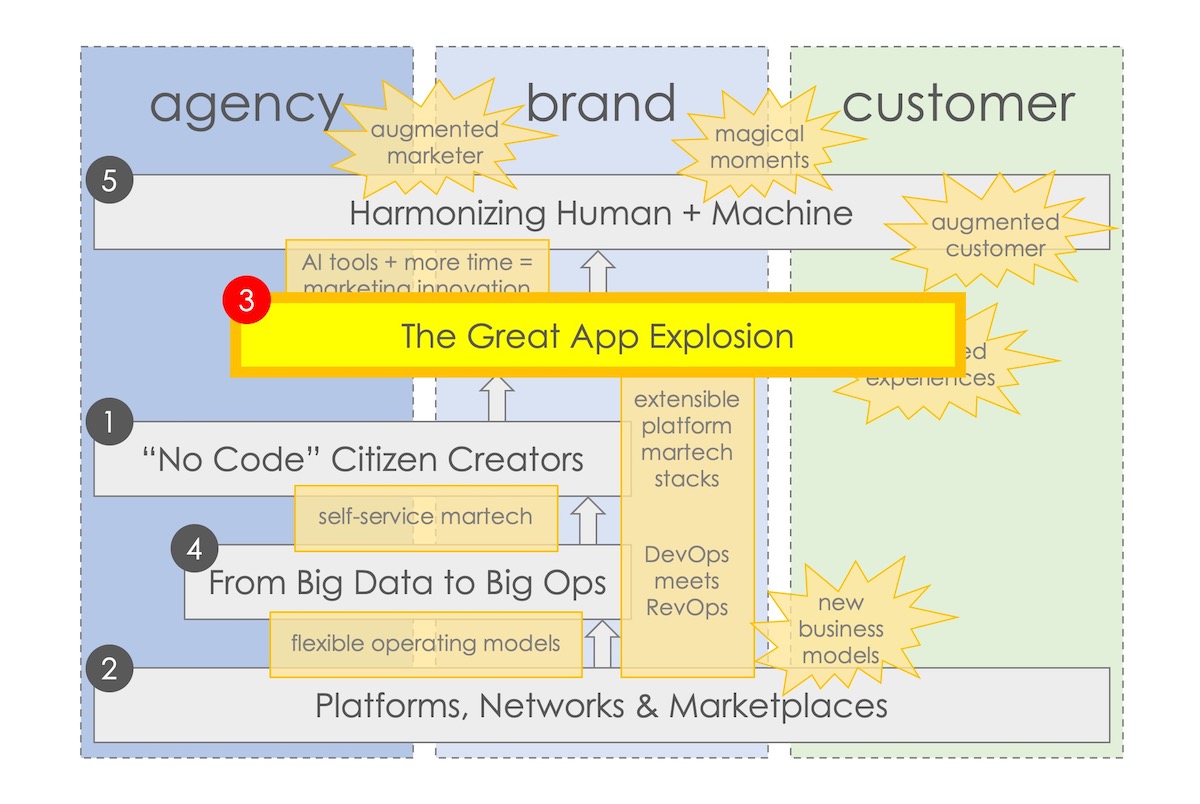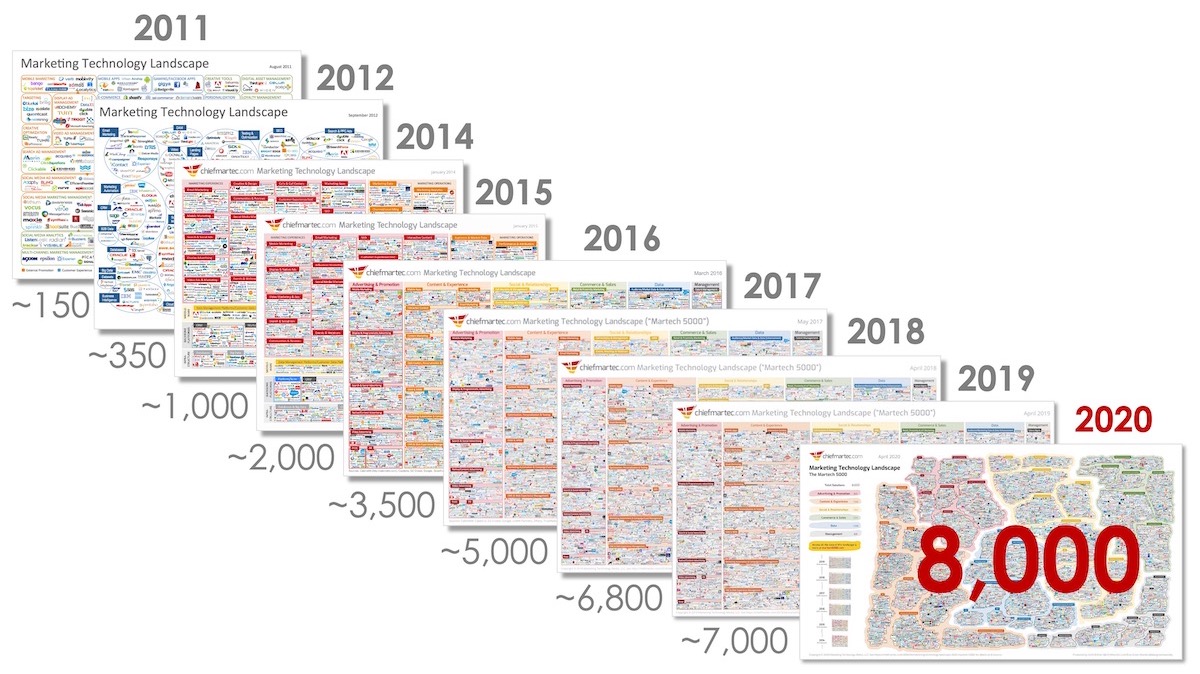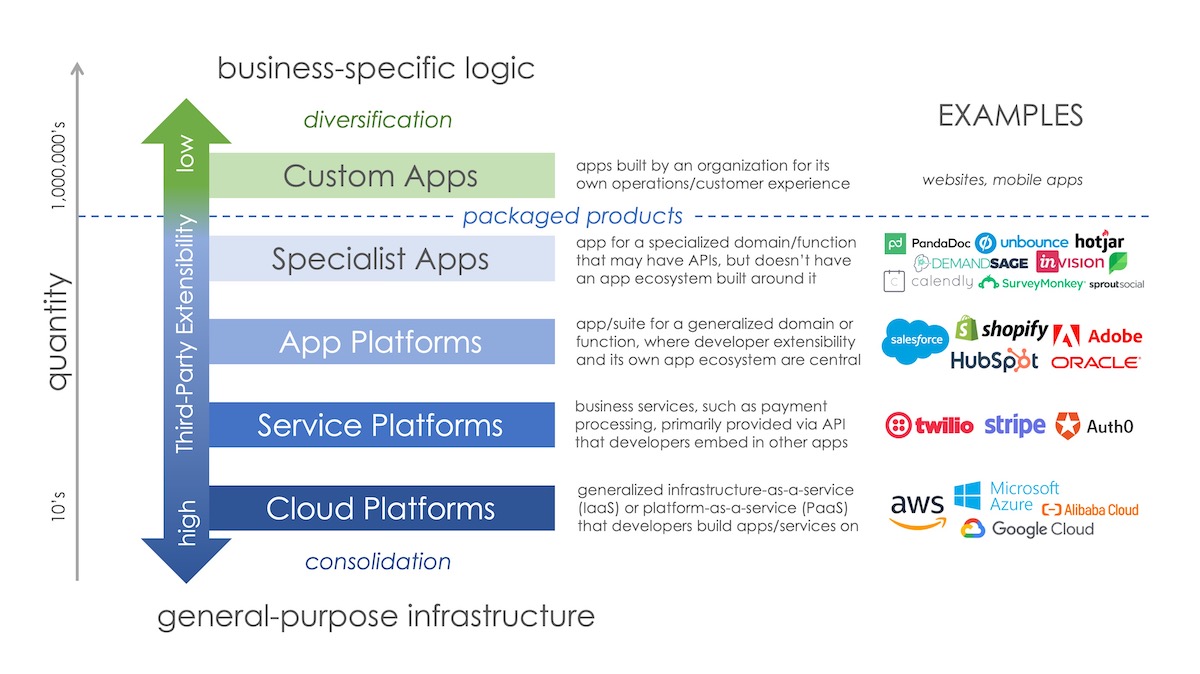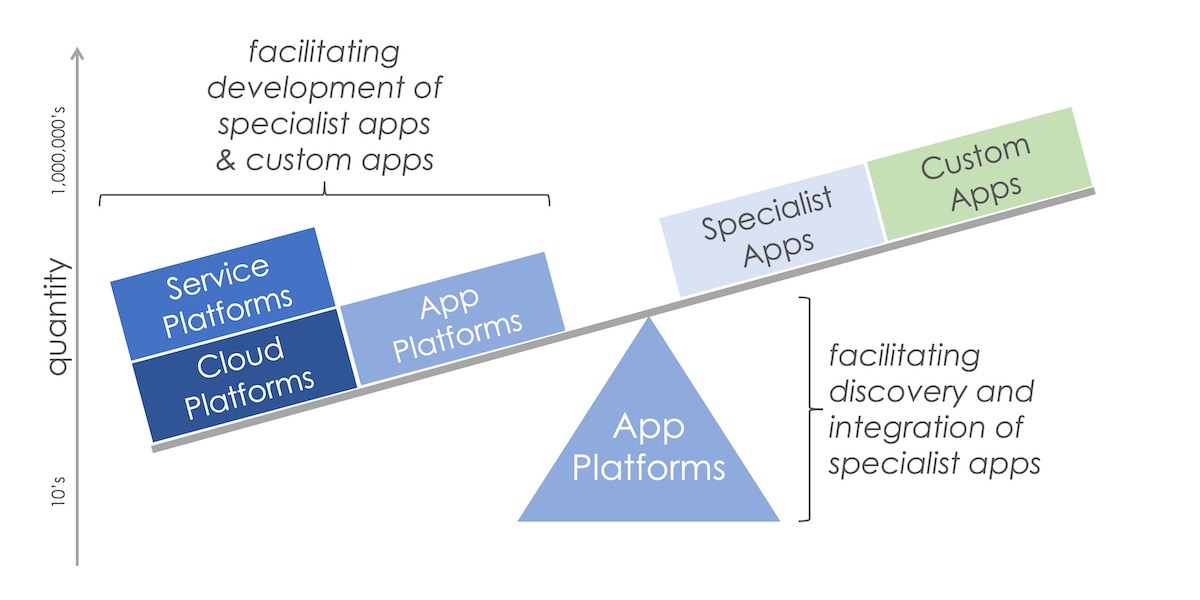Earlier this year, I collaborated with Jason Baldwin, global head of product management at WPP, on this project to describe five major trends in martech that would shape the decade ahead for agencies and brands. You can download our full paper, including many terrific interviews from WPP executives. I’m republishing it here as a 7-part series. This is part 4.
The annual marketing technology landscape, produced since 2011, has been a source of heated debate. It’s a single slide with logos of the many different marketing technology products that we organized into categories. It has grown exponentially over the past decade.
The 2011 martech landscape had around 150 solutions. By 2014, it had grown to nearly 1,000. The next year: 2,000. Then 4,000. The most recent edition released in the spring of 2020 had a whopping 8,000. That’s an eye-popping 5,233% growth over the decade.
Each year, the graphic would trigger cries by industry analysts and overwhelmed marketers that the martech industry was bound to consolidate. It was ridiculous to have thousands of vendors! Yet every year, the landscape continued to grow. How was this even possible?
In truth, there has been significant consolidation in the martech space. Hundreds of companies have been acquired or driven out of business by their competitors. And the largest marketing technology vendors who have achieved scale as public companies — Adobe, HubSpot, Oracle, Salesforce, etc. — have achieved dominant market share in many martech categories.
Yet still the total number of martech solutions on the market grows. Why? How?
THE NEW ECONOMICS OF SOFTWARE
First, we must recognize that the economics of launching a software product these days are a fraction of what they once were. Cloud platforms such as Amazon AWS, Google Cloud, and Microsoft Azure let any entrepreneur working out of their home spin up world-class, global infrastructure for running a software-as-a-service (SaaS) app in a matter of minutes. They only pay for what they use, at costs measured in infinitesimal slivers of cents, which scale smoothly with the growth of their business.
Software entrepreneurs can leverage free open source frameworks. They can add major swaths of functionality to their products simply by inserting a few lines of code from API-based service platforms, such as Twilio and Stripe, which instantly give them state-of-the-art communications features and a robust payments engine. They can tap engineering expertise on-demand from developer communities, such as Github and Stack Overflow, and freelance marketplaces, such Fiverr and Upwork.
Most apps can be launched with very little capital today, which has resulted in a wave of bootstrapped SaaS businesses. And when startup money is needed, it is available from a plethora of sources beyond traditional venture capital: accelerators such as YCombinator, crowdfunding sites such as Kickstarter, new “alt VC” organizations such as TinySeed and Earnest Capital, revenue-based financing, and more.
There are effectively zero barriers to entry to getting into the software business.
It’s also easier than ever to buy apps. Many apps can be purchased by business users with a credit card and immediately used in a web browser. Freemium and free trial apps make it even easier to get started: try an app out and see if you find it useful. More complex and expensive products take longer to buy and configure, but even those deployments have far less friction today than previous on-premise solutions in the era that preceded the cloud.
The demand for apps is nearly unlimited. Marketers are constantly looking for innovations that will give them a competitive edge — a new tactic, a new channel, a new customer experience. They’re continually striving to optimize their operations with more specialized tools and digital services that are tailored to their needs. It’s a kind of digital arms race.
The biggest hurdle to app adoption in marketing has been integration. You could assemble a stack of “best-of-breed” apps — software passionately focused on serving one specific need better than anything else in the market — but getting them to interoperate was challenging.
However, that dynamic is changing rapidly thanks to the rise of app platforms in the cloud. As explained with the trend of platforms, networks, and marketplaces, software platforms provide a common foundation for apps that are integrated or built on top of them to work together.
App platforms standardize data models, services, and user interfaces to create coherence and consistency across everything plugged into them. Think of your iPhone or Android smartphone and how effortless it is to add new apps. We’re not quite there with B2B app platforms, but in the decade ahead, we will be.
This gives businesses the best of both worlds: unified digital infrastructure, anchored by stable app platforms, and near infinite means of innovating and differentiating through specialist apps — or custom apps they build themselves — layered on top of that foundation.
By removing the hurdles of integration, app platforms further reduce the barriers to creating and adopting apps. In addition to simplifying technical interoperability between apps, many app platform companies also run app marketplaces to make it easy for businesses to discover compatible specialist apps in their ecosystem. In turn, these marketplaces give smaller app developers targeted go-to-market channels for distributing their products — even relatively tiny “micro-apps,” plug-ins, and extensions.
In May 2020, Pandium released a State of Product Integrations at the SaaS 1000 report that examined integrations, public APIs, and “app centers” offered by the 1,000 fastest growing SaaS companies from 2019.
They found that nearly every SaaS company now integrates with other SaaS companies in the cloud — the median was 15 integrations each. In the martech category, 61% had an “app center” (from a simple directory to a transactional marketplace) featuring available integrations. 89% of them provided APIs to their customers.
All these elements combine to multiply the number of apps in the world. In fact, the larger and more consolidated cloud platforms, service platforms, and app platforms become, the further they accelerate development of more specialist apps and custom apps built on top of them.
THE GREAT APP EXPLOSION
In a Worldwide IT Industry 2020 Predictions report published a year ago, IDC estimated that “over 500 million digital apps and services will be developed and deployed using cloud native approaches” by 2023.
By 2030, there will be billions and billions of apps in the world.
This is The Great App Explosion.
To get a sense of the scale of The Great App Explosion already underway, consider that two years ago there were already over 100 million software project repositories in GitHub. By 2030, there will be an estimated 45 million developers in the world. If we count apps built by no code tools — and why shouldn’t we? — it’s easy to appreciate how billions of apps can be created.
Of course, most of these apps won’t be stand-alone software businesses. The vast majority of them will be custom apps built by companies for their own internal needs. The next largest set will be those built by businesses for their customers — not as stand-alone software businesses either, but as outward-facing, digital facets of their products and services.
For example, a direct-to-consumer (D2C) brand will build their own custom web apps to serve customers on their site. But they will also develop custom mobile apps, chatbots for messenger platforms, voice assistant skills, widgets for affiliates to embed on other websites, API services for partners in their supply chain, and so on.
More and more businesses will be “digital natives,” 100% powered by a kaleidoscopic tapestry of apps built, bought, or rented, all interconnected through APIs in public and private clouds. At the same time, the line between purely digital businesses and those with some kind of presence in the physical world will blur. Digital touchpoints will proliferate through physical spaces and objects, and everything will be orchestrated digitally.
THE ATOMIZATION OF APPS
By 2025, IDC estimates there will be 41.6 billion Internet of Things (IoT) devices connected in the world, including wearables, sensors, appliances, vehicles, TVs, speakers, and more. Each of these hardware devices runs its own software apps on the “edge” of the cloud. Some are so tiny as to be considered not just micro-apps but nano-apps.
This atomization of apps will not only geometrically explode the number of apps in the world. It will imbue everything in our lives with software intelligence. Asymptotically, everything will be an app.
5G networks, with an order of magnitude greater bandwidth, will make it feasible to deliver these apps instantaneously on-demand. App Clips in Apple’s recent iOS 14 release are an example of this kind of install-less software experience. As mobile bandwidth continues to increase — 6G networks later in the decade are predicted to have terabit-per-second speeds — the size of apps and their media payloads (think augmented and virtual reality) that can be instantly deployed will grow by orders of magnitude.
For brands and agencies, this appification of the world represents an unprecedented canvas for creativity. Customer experiences can be crafted across a myriad of digital touchpoints, a suite of apps and micro-apps all working in concert to amaze and delight.
These richer brand experiences will begin earlier in the customer journey, as even ads become micro-apps that are capable of intelligence and interactivity. Indeed, the difference between an “ad” and a free, just-in-time digital service beamed contextually to a device or media platform that a consumer is engaged with will be hard to distinguish. They will power interactive content and visual commerce everywhere.
More and more marketing assets will be software. As such, marketing operations and broader revenue operations — RevOps — will take on more characteristics of DevOps, the hybridized discipline of software development and deployment in the cloud. Customer journey lifecycles and software development lifecycles will increasingly intersect and blend.
One of the most important aspects of this hybrid RevOps/DevOps mission will be managing the gargantuan volume of data flowing in and out of all of these apps.
This segues into our next trend…
Continue reading with Trend #4: From Big Data to Big Ops. You can also download the full paper at any time.







